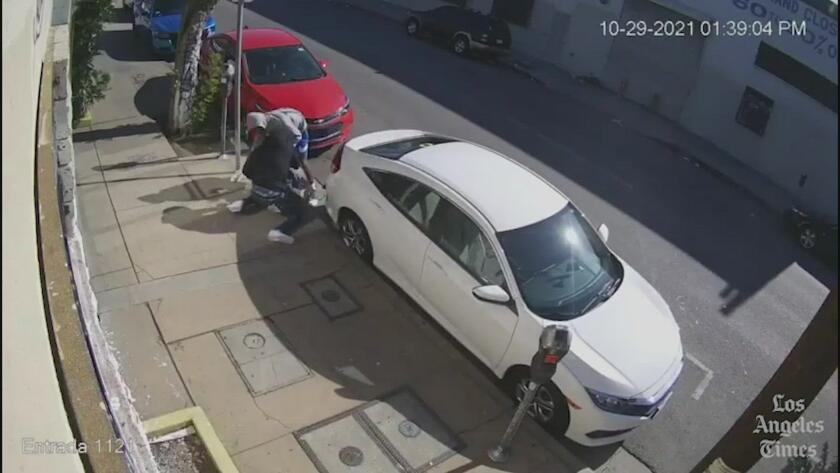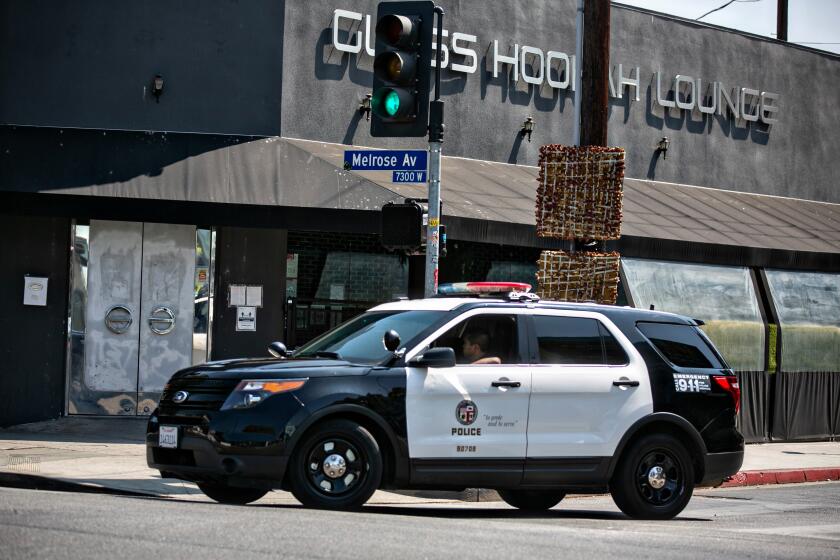17 L.A. gangs have sent out crews to follow and rob city’s wealthiest, LAPD says
- Share via
Surveillance video captured a man being chased down and robbed on the street in downtown Los Angeles in October.
- Share via
More than a dozen Los Angeles gangs are targeting some of the city’s wealthiest residents in a new and aggressive manner, sending out crews in multiple cars to find, follow and rob people driving high-end vehicles or wearing expensive jewelry, according to police.
In many cases, they’re making off with designer handbags, diamond-studded watches and other items worth tens of thousands of dollars — if not more — and then peddling them to black-market buyers who are willing to turn a blind eye to the underlying violence, police said.
In some cases, suspects have been arrested but then released from custody, according to police, only to commit additional robberies.
Those are among the conclusions of a Los Angeles Police Department task force convened at the end of last year to identify the cause of a sudden surge in “follow-home,” or “follow-off,” robberies, so called because victims are robbed soon after leaving luxury boutiques and hotels, ritzy restaurants, trendy nightclubs and other locations where the gangs are scouting for targets.
According to Capt. Jonathan Tippet, who spearheads the task force, police have identified at least 17 gangs, most based out of South L.A. and operating independently, that are involved. There were 165 such robberies in 2021 and 56 so far this year, he said, including several over the weekend.
The area with the most robberies during that time was the LAPD’s Hollywood Division, with 50, followed by 46 in the Wilshire Division and 40 in the Central Division, which includes downtown. The Pacific Division had 17, West L.A. 15, North Hollywood 14 and Topanga 11.
Tippet did not say how many robberies police attributed to which gangs, but said individuals allegedly affiliated with both the Bloods and Crips have been identified among the culprits. Suspects whom police have identified have pleaded not guilty, and their cases are pending. The task force is still working to build cases against other suspects.
Through surveillance video and other evidence, police have identified crews rolling three to five cars deep in some of the attacks, Tippet said, with gang members jumping out and blindsiding victims.
“There’s no chance or opportunity for these victims even to comply. They’re just running up to people and attacking them, whether that’s putting a gun in their face or punching them and beating on them,” Tippet said. “Pistol whipping them as well.”
A series of high-profile crimes in upscale parts of Los Angeles — “smash-and-grab” and “follow-home robberies” — have gotten widespread attention in recent months.
In some cases, police determined that gang members inside high-end venues served as “spotters” for those outside, Tippet said, alerting them when wealthy targets were heading out.
Shots have been fired in 23 cases, and two victims have been killed, said Tippet, who also heads the LAPD’s Robbery-Homicide Division, which investigates high-profile crimes.
“In my 34 years on the job, I’ve never seen anything like this,” he said.
The trend, in a city known for opulence as well as extreme poverty, comes at a time when crime overall is under a microscope — with homicides, shootings and armed robberies all at elevated levels since the start of the COVID-19 pandemic and candidates in the city’s ongoing mayoral race denouncing those increases as they vie for voters and wealthy donors.
That intense focus has also caused some consternation among activists and criminal justice reform advocates, who worry that wealthy residents with political clout and politicians eager to please them will use the trend — based in part on fraught and sometimes false police assessments of gang involvement — to claw back past policing reforms.
One prominent activist, Hamid Khan, on Tuesday accused the LAPD of “week after week of sensationalism” about crime in the city, suggesting police were blowing crime trends out of proportion to maintain their grip on the city’s budget.
“LAPD has to constantly legitimize itself, constantly has to make itself useful to the community, by raising this specter of people running wild,” Khan said.
Police said their intent is simply to draw attention to — and halt — a serious and potentially deadly surge in armed robberies.
Still, much of the increasing violence has affected not the wealthy, but the city’s more vulnerable populations, such as people who are homeless or live in poor communities, and receives little notice.
The follow-off robberies first started gaining attention toward the end of last year, when the number of incidents spiked dramatically and celebrities started to fall victim — including actor and former BET host Terrence Jenkins and “Real Housewives of Beverly Hills” star Dorit Kemsley.
In a four-week period from September to October, there were 45 follow-off robberies. In November, there were another 39, Tippet said.
LAPD Chief Michel Moore announced the formation of the task force that month. Tippet briefed the civilian Police Commission on the task force’s work since then on Tuesday.
He said the task force has made 24 robbery arrests involving 47 robberies, as well as 16 gun arrests and six attempted murder arrests. It also has arrested four people for murder in the two homicides it has investigated, he said.
Along the way, the task force has served 278 search warrants, Tippet said, nearly 200 of which were to search digital media or other technology, 35 for homes and 20 for vehicles.
In an interview with The Times, Tippet said the task force’s efforts have made a substantial difference, driving down the number of incidents to just 10 in March.
However, robberies have ticked back up again in recent weeks, and the trend is still a major concern, he said, in part because those same suspects keep getting released from jail and reoffending while awaiting trial.
“I am absolutely frustrated,” he said.
Similar frustration was shared last week by Moore, when he took the unusual step of briefing the Police Commission on the alleged actions of one such suspect: 18-year-old Matthew Adams.
The LAPD says robbers are following people home to break into their houses; recent targets include Terrence Jenkins and Dorit Kemsley.
Adams, according to Moore, was involved in eight separate follow-off robberies over a sixth-month period starting last fall, including one in which two UCLA students were robbed of two watches worth nearly $145,000 after leaving a club, a second in which two foreign tourists were robbed of watches worth $73,000, and a third in which $51,000 in property was stolen.
During the course of the eight robberies, which occurred between September and February, Adams was arrested three times. The first time was on Jan. 9, when Moore said Adams was found in a car that had been used in one of the robberies and where a gun was also found. Online court records show no charges were ever filed against Adams in that case, suggesting prosecutors were unconvinced they could win a conviction.
Adams was arrested again on Jan. 27 and a third time on Feb. 21, and in both cases charged with illegal gun possession. Court records show he was ordered released each time without having to pay bail. The reason was a pandemic-related rule, aimed at reducing the jail population, that requires L.A. County defendants to be released without posting bail for certain offenses.
Adams, who could not be reached for comment, has since been arrested a fourth time on charges related to seven robberies, to which he has pleaded not guilty. The public defender’s office, which represented him during his arraignment, declined to comment on the case. He remains in custody, according to court records.
Moore said Adams’ earlier and repeated releases from custody endangered public safety, and that people who are repeatedly arrested for gun crimes should not be let out before trial. He also suggested that prosecutors played a part by not seeking certain charging enhancements to those brought against Adams that might have kept him in jail.
Moore said he was “disappointed” that “the full weight of our existing laws” was not brought down on Adams — not only to hold him accountable, but to provide a disincentive for other would-be robbers who might think such crimes are going unpunished in L.A.
When asked about Moore’s claims, a spokesman for L.A. County Dist. Atty. George Gascón’s office said Adams was not legally eligible for gun enhancements on the two possession charges.
Gascón’s office did file gun enhancements in the latest case against Adams, the spokesman said.
In a separate case, a man named Cheyenne Hale, 25, was arrested this month on suspicion of participating in the armed robbery of a man in downtown L.A. in October in which two watches estimated to be worth about $600,000 were stolen.
Police said they recovered a loaded gun from Hale during his arrest and that detectives in Tippet’s unit later found seven additional handguns, $21,000 in cash and “a large quantity of drugs” including cocaine and methamphetamine when they served a search warrant at Hale’s home.
Nonetheless, Hale — who could not be reached for comment — has since been released from custody, according to court records.
Following Moore’s presentation last week, Police Commission President William Briggs said that the pretrial release of individuals allegedly involved in violent robberies at gunpoint represented a failure of the criminal justice system.
“This revolving-door criminal justice system that we have right now clearly is not working and is endangering the citizens of Los Angeles and is creating a public safety crisis,” Briggs said. “We need to find a solution.”
After Tippet’s presentation Tuesday, which included videos from two recent robberies, Briggs said the footage showed an “outrageous display of arrogance on the part of these criminals, to think they can just run amok in our city and terrorize our citizens.”
Other commissioners have seemed wary of focusing too heavily on the trend, or too intensely on Adams or any other individual defendant, particularly before they’d had their day in court.
Commissioner Dale Bonner last week said discussions about individual “career criminals” have been misused by politicians to stoke fear in the community and advance questionable criminal justice initiatives in the past, and that the current discussion should not fail to recognize that.
Tippet said his task force would continue investigating such crimes, and that he hopes that its work will encourage those engaged in such robberies to stop doing what they’re doing.
He also said that people who are buying the watches, handbags and other goods being stolen during such robberies should also stop what they’re doing — because the task force is coming after them as well as part of multiple open investigations.
“They are participating” in the crime, too, Tippet said.
More to Read
Sign up for Essential California
The most important California stories and recommendations in your inbox every morning.
You may occasionally receive promotional content from the Los Angeles Times.














